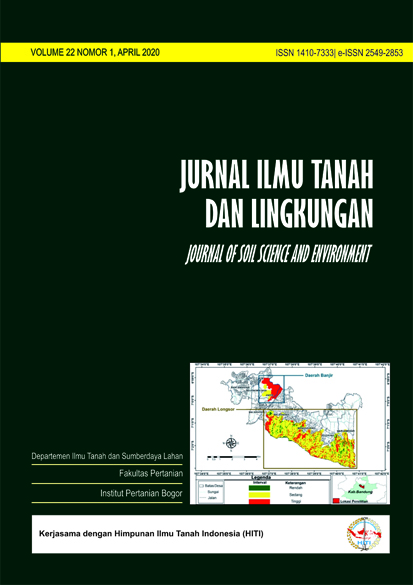Partly Substitution of Chemical Fertilizer with Bio-organic Fertilizer on Maize (Zea mays)
Substitusi Sebagian Pupuk Kimia dengan Pupuk Organik Hayati pada Jagung (Zea mays)
Abstract
High amount of chemical fertilizer application simultanously caused soil degradation and environmental pollution. Bio-organic fertilizer application increases nutrient availability, improve soil properties, promote plant growth and increase yield. This study aims to understand effects of chemical fertilizer substitution with bio-organic fertilizer application on growth, uptake of N, P, K, and agronomic efficiency of maize in vegetative phase. Pot experiment was conducted at IPB Cikabayan Experimental Station, Dramaga, Bogor. Laboratory analysis was done at Department of Soil Science Laboratory, Faculty of Agriculture, Bogor Agricultural University (IPB). Randomized Block Design with single factor was used in this experiment. The treatments were: Control, POH (bio-organic fertilizer only), POH + 50% (NPK), POH + 100% (NPK), 50% (NPK) , and 100% (NPK). Bisma maize variety was used as plant indicator. Five weeks after transplanting, the biomass (shoot and roots) biomass ware harvested. NPK uptake analysis was performed to shoot samples. Results showed that bio-organic fertilizer application reduced the rate of chemical fertilizer by 50% and increase N, P, and K uptake. Combination between bio-organic fetilizer and 50% chemical fertilizer had the highest agronomic efficiency. Bio-organic fertilizer substitute 50% chemical fertilizer of maize.
Downloads
References
Anas, I. 2016. Pentingnya Bioteknologi Tanah dalam Mencapai Sistem Pertanian yang Berkelanjutan, Orasi Ilmiah Guru Besar IPB. Bogor, Indonesia : 9 April, 2016, Bogor, Indonesia. IPB Press, Bogor.
Babalola, O.O. 2010. Beneficial bacteria of agricltural importance. Biotechnology Letter, 32 : 1559-1570.
Cassan, F. and M. Diaz-Zorita. 2016. Azospirillum sp. In current agriculture: From the laboratory to the field. Soil Biology and Biochemistry, 117-130.
Chuan, L., P. He, M.F. Pampolino, A.M. Johnston, J. Jin, X. Xu, S. Zao, S. Qiu and W. Zhou. 2013. Establishing a scientific basis for fertilizer recommendations for wheat in China : Yield response and agronomic efficiency. Field Crops Research, 140 : 1-8.
Jarell, W.M. and R.B. Beverly. 1981. The dilution effect in plant nutrition studies. Advances in Agronomy, 34: 197-224.
Kalhapure, A.H., B.T. Shete and M.B. Dhonde. 2013. Integrated nutrient management in Maize (Zea mays L.) for increasing production with sustainability. International Journal of Agriculture and Food Science Technology, 4(3): 195-206.
Larsen, J., H. Pineda-Sánchez, I. Delgado-Arellano, V. Castellano-Morales, L. Carreto-Montoya and J. Villegas-Moreno. 2017. Interactions between microbial plant growth promoters and their effects on maize growth performance in different mineral and organic fertilization scenarios. Rhizosphere, 3: 75 – 81.
Li, H., W. Feng, X. He, Z. Ping, H. Gao, N. Sun and M. Xu. 2017. Chemical fertilizers could be completely replaced by manure to maintain high maize yield and soil organic carbon (SOC) when SOC reaches a threshold in the Northeast China Plain. Journal of Interactive Agriculture, 16(4): 937 – 946.
Santi, C., D. Bogusz and C. Franche. 2013. Biological nitrogen fixation in non-legume plants. Annals of Botany, 111: 743-767.
Savci, S. 2012. Investigation of effect of chemical fertlizers on environment. APCBEE Proceedia, 287-292.
Setiyowati. 2011. Penambahan mikrob pemacu tumbuh untuk meningkatkan kualitas pupuk organik, serapan hara, pertumbuhan, serta produksi padi gogo dan jagung [Tesis]. IPB, Bogor.
Sharma, S.B., R.Z. Sayyed, M.H. Trivedi and T.A. Gobi. 2013. Phosphate solubilizing microbes: Sustainable approach for managing phosphorus deficiency in agricultural soils. SpringerPlus, 2: 587 – 601.
Taiz, L. and E. Zeiger. 2002. Plant Physiology. 3rd ed. Sinauer Associates, Sunderland, United States.
Van der Heijden, M.G.A., R.D. Bardgett and N.M. Van Straalen. 2008. The unseen majority: soil microbes as drivers of plant diversity and productivity in terrestrial ecosystems. Ecology Letters, 11: 296 – 310.
Xu, X., P. He, M.F. Pampolino, A.M. Johnston, S. Qiu, S. Zhao, L. Chuan and W. Zhou. 2014. Fertilizer recommendation for maize in China based on yield response and agronomic efficiency. Field Crops Research, 157: 27-34.
Department of Soil Science and Land Resources Departemen Ilmu Tanah dan Sumberdaya Lahan, Faculty of Agriculture Fakultas Pertanian, IPB University



















